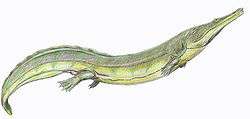Trematosauridae
| Trematosauridae Temporal range: Triassic, 249.7–220 Ma Possible Jurassic record | |
|---|---|
| | |
| Fossil of Trematolestes hagdorni in the State Museum of Natural History Stuttgart | |
| Scientific classification | |
| Kingdom: | Animalia |
| Phylum: | Chordata |
| Order: | †Temnospondyli |
| Suborder: | †Stereospondyli |
| Superfamily: | †Trematosauroidea |
| Family: | †Trematosauridae Watson, 1919 |
Trematosauridae are a family of large temnospondyl amphibians with many members. They first appeared during the Olenekian stage of the Early Triassic, and existed until around the Carnian stage of the Late Triassic,[1] although by then they were very rare. By the Middle Triassic they had become widespread throughout Laurasia and Gondwana with fossils being found in Europe, Asia, Madagascar, and Australia.

They are one of the most derived families of the Trematosauroidea superfamily in that they are the only family that have fully marine lifestyles.[2] Long, slender snouts that are characteristic of the trematosaurids, with some members having rostrums resembling those of modern-day gavials. Traditionally, two subfamilies within Trematosauridae can be identified, the relatively short-nosed Trematosaurinae and the long-nosed Lonchorhynchinae.[3] A third subfamily, Tertreminae, was named in 2000 and includes broad-snouted forms like Tirraturhinus. Below is a cladogram from Steyer (2002) showing the phylogenetic relationships of trematosaurids:[4]
A possible trematosaurid has been found in the Toutunhe Formation in the Junggar Basin. If this analysis is accurate, it renders Trematosauridae one of the longest lived lineages of Temnospondyli, having lasted as recently as the late Jurassic.[5]
| Trematosauridae |
| |||||||||||||||||||||||||||||||||||||||||||||||||||||||||
References
- ↑ Schoch, Rainer R., Milner, Andrew R. & Hellrung, Hannah (2002), “The last trematosaurid amphibian Hyperokynodon keuperinus revisited”. Stuttgarter Beiträge zur Naturkunde, Ser. B Nr. 321
- ↑ Steyer, Sébastien J. (2002). “The First Articulated Trematosaur 'amphibian' from the Lower Triassic of Madagascar: Implications for the Phylogeny of the Group”. Palaeontoogy, 14(4): 771-793
- ↑ Damani, Ross (2004). “Cranial anatomy and relationships of Microposaurus casei, a temnospondyl from the MiddleTriassic of South Africa”. Journal of Vertebrate Paleontology, 24(3): 533–541
- ↑ Steyer, J. S. (2002). "The first articulated trematosaur ‘amphibian’ from the Lower Triassic of Madagascar: implications for the phylogeny of the group". Palaeontology. 45: 771–793. doi:10.1111/1475-4983.00260.
- ↑ (Maisch et al. 2004, p. 582)
External links
| Triassic Period | ||
|---|---|---|
| Lower/Early Triassic | Middle Triassic | Upper/Late Triassic |
| Induan |Olenekian | Anisian | Ladinian | Carnian | Norian Rhaetian |